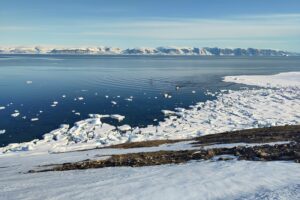“Unprecedented” ocean warming could make key habitats “inhospitable” for critically endangered angelsharks, according to new research.
The study, published in Global Change Biology, finds an “abnormal absence” of female sharks in a marine reserve near the Canary Islands throughout the 2022 breeding season.
This occurred during “unusually high” sea surface temperatures across the north-east Atlantic Ocean.
The study notes that the number of days with sea surface temperatures above 22.5C in the reserve nearly tripled over 2018-23.
This is significant, the authors say, because 22.5C is a “possible upper thermal threshold” for female angelsharks to tolerate.
The authors warn that ocean warming has “already altered” angelshark breeding behaviour, adding that the findings show that the species is “more acutely vulnerable” to climate change than previously thought.
Ocean warming
Angelsharks are flat-bodied, ray-like predators that can grow up to 2.4 metres in length.
They are typically found submerged in sandy habitats in the coastal waters of the north-east Atlantic Ocean and Mediterranean Sea.
They are listed as critically endangered on the International Union for Conservation of Nature’s (IUCN) red list of threatened species.
The authors note that the angelshark population has “declined substantially” due to “overexploitation” and “coastal habitat degradation”.
In the study, the researchers focus on the La Gaciosa Marine Reserve in the Canary Islands – Spain’s largest marine reserve.
The study notes that the Canary Islands are an “especially important region” for the angelshark and are at the “southernmost” boundary of the species’ distribution. As a result, angelshark populations around the islands have a “possibly lower tolerance for environmental change”, it states.
The researchers add that the north-east Atlantic Ocean is “undergoing rapid warming, characterised by exceptionally high temperatures and record-breaking marine heatwaves”.
As the climate continues to warm, extreme conditions are expected to occur more frequently and for longer, causing disruption to marine life.
The map below shows the historic and existing range of angelshark populations, as well as the locations of the acoustic receivers used to detect angelsharks in the study area.
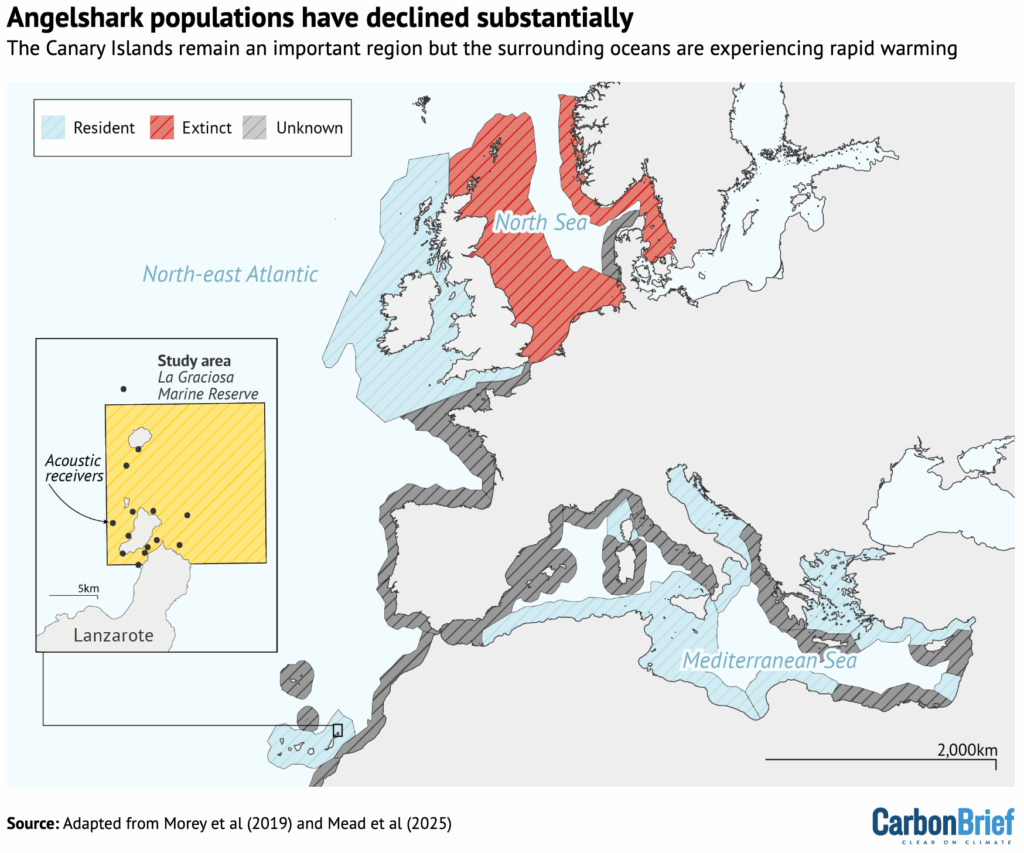
To explore how climate change in the region is impacting the angelsharks, the researchers focus on “range shift”.
Range shift is when a species migrates to either remain in ideal conditions or avoid sub-optimal environments, according to what they can withstand as the climate changes.
It is one of the most “pervasive” consequences of ocean warming, the study authors say.
Tracking angelsharks
To track the movements of angelsharks, the researchers tagged the fins of 112 animals – 38 males and 74 females – over 2018-22.
These “acoustic tags” emit sound that enabled the researchers to remotely track angelshark locations.
The researchers then used this acoustic data to investigate seasonal and annual changes to angelshark presence at the study site, taking into account the contrast between male and female behaviours.
The researchers also modelled changes to the environment over 2021-23 using a range of variables. These included sea surface temperature (SST), salinity, surface wind speed and SST anomaly – a measure of how temperatures differ from the long-term average.
They also looked at concentrations of chlorophyll a and dissolved oxygen, as well as two variables that act as an indicator for levels of desert dust in the air.
The latter were used to incorporate into their model the effect of Calima events – hot and dusty winds that reach the Canary Islands from the Sahara Desert, which raise overall air temperatures.
This “environmental model” allowed the authors to investigate the relationship between angelshark presence within the reserve and changing environmental conditions.
‘Marked absence’
Previous research has linked seasonal angelshark behaviours – such as movement and presence in a certain habitat – to the breeding cycle and, sometimes, environmental factors.
The new study finds that angelshark presence in the study area varies seasonally for both sexes, peaking in November and December. It notes an additional peak in June for female angelsharks, which were also more “consistently present” in the study area throughout the year than males.
Author Dr David Jacoby is a lecturer in zoology at Lancaster University. He explains to Carbon Brief:
“Females will often avoid males outside of the breeding season as mating is pretty violent and energy expensive in sharks. Females consequently are more likely to occur in shallow water [since] males [are more likely to be found] in deeper water.”
The charts below show the relative influence of different environmental variables on predicting male and female shark presence in the study area.
The chart on the left shows how the day of the year has the biggest influence on male angelshark presence, followed by salinity. The chart on the right shows that for female angelsharks, SST – followed by SST anomaly – was the most significant predictor.
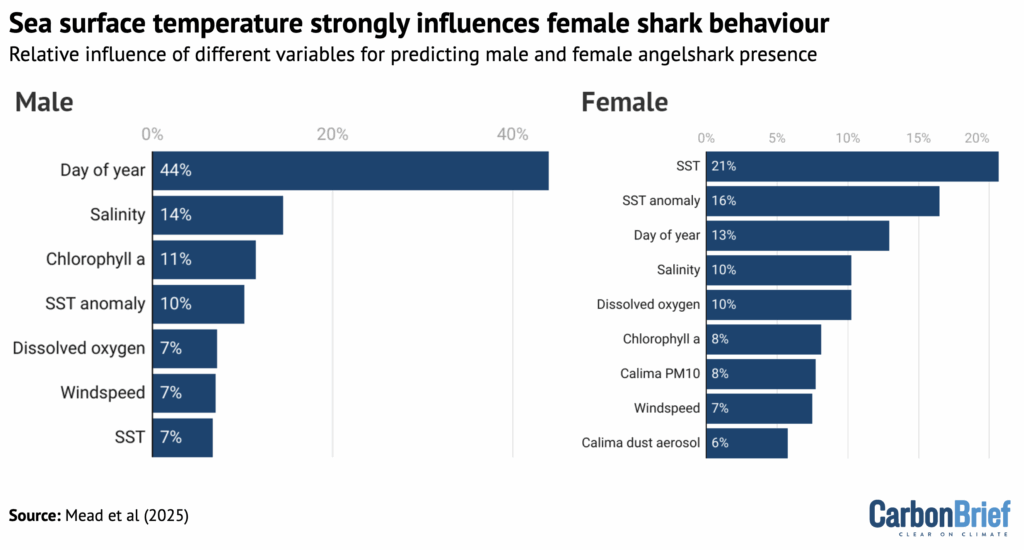
The “crux” of the study, according to Jacoby, is that in 2022 – when peak SSTs were higher and those conditions lasted longer – female angelshark numbers were “consistently low”. He tells Carbon Brief:
“The fact that there was this significant warming event in the north-east Atlantic was opportunistic from a research perspective at least, because it provided a natural experiment in which to directly compare behaviour under ‘normal’ versus ‘extreme’ conditions.”
This “marked absence” was especially noticeable during the angelshark breeding season in mid-to-late autumn, the data shows. In contrast, the behaviour of the male sharks did not change.
The charts below illustrate how, in 2022, daily counts of female angelsharks (orange bars in the middle panel) dropped in the unusually warm conditions, while daily counts of male angelsharks (turquoise bars in the bottom panel) remained consistent with previous years.
In the top panel, orange regions indicate periods in which SSTs are between 20.7C and 22.5C and red regions show periods of SSTs above 22.5C.
According to the authors, the presence of female sharks in the study site decreases “rapidly” at SSTs above 20.7C, while the “probability of female presence” is below zero above around 22.5C.
The dotted line at 19.6C shows the temperature of peak female angelshark presence.
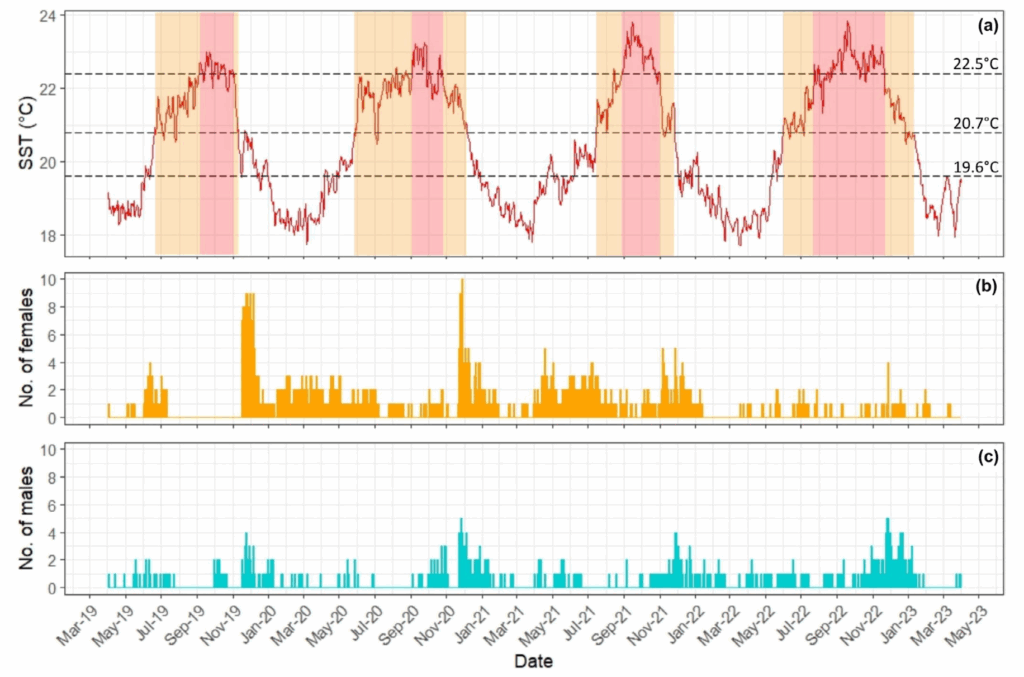
The researchers say their findings “strongly” indicate that the low numbers of females during the breeding season in 2022 were linked to the “thermal extremes” that year.
They point to an “upward trend” in peak temperatures and longer duration of hotter periods in their dataset, noting that the number of days where SSTs reached 22.5C more than doubled over the study period.
As a result, the authors identify 22.5C as the “possible upper thermal threshold” for female angelsharks – meaning that the animals will not move into an area at this point.
They warn that regular temperatures of 22.5C could “disrupt” the timing of “key biological events”, such as breeding.
The “unusual” findings, recorded as “disrupted” thermal cues, may be a “window into future climate change impacts”, suggest the authors.
Conservation measures
The authors highlight the need to prioritise further “species-specific” studies that incorporate “real-time environmental and behavioural data” and explore climate impacts by sex.
Improving scientific understanding and prediction of how marine species and ecosystems respond to climate change are “urgent priorities”, they say.
Jacoby adds:
“Angelsharks [are among] the most threatened fishes in the world. Because they rely on the ocean floor to rest and hunt, they are extremely attuned to their local environment. [Ocean warming] could lead to the [local extinction] of this species from the archipelago in a very worst case due to the fact that they are already at their thermal extreme in this location…
“We still don’t really know how warming could impact the complex web of interactions within these coastal ecosystems. It is so hard to engage with a problem if you can’t see it for yourself.”
Dr Hollie Booth is a postdoctoral researcher in the department of biology at the University of Oxford and was not involved in the study. She tells Carbon Brief that although the negative impacts of climate change are “concerning”, overfishing remains “the greatest direct threat” to angelshark populations.
She adds:
“It is good to see empirical evidence of the impacts of climate change on threatened marine species. [The study] indicates how we need to make sure that contributors to climate change are also held accountable for mitigating [these] impacts.”
The post Endangered angelshark faces ‘inhospitable’ breeding sites as ocean warms appeared first on Carbon Brief.
Endangered angelshark faces ‘inhospitable’ breeding sites as ocean warms
Greenhouse Gases
Ricky Bradley named Citizens’ Climate Executive Director after strategic and legislative progress during interim leadership role
Ricky Bradley named Citizens’ Climate Executive Director after strategic and legislative progress during interim leadership role
 Dec. 22, 2025 – After a six month interim period, Ricky Bradley has been appointed Executive Director of Citizens’ Climate Lobby and Citizens’ Climate Education. The decision was made by the CCL and CCE boards of directors in a unanimous vote during their final joint board meeting of 2025.
Dec. 22, 2025 – After a six month interim period, Ricky Bradley has been appointed Executive Director of Citizens’ Climate Lobby and Citizens’ Climate Education. The decision was made by the CCL and CCE boards of directors in a unanimous vote during their final joint board meeting of 2025.
“Citizens’ Climate Lobby is fortunate to have someone with Ricky Bradley’s experience, commitment, and demeanor to lead the organization,” said CCL board chair Bill Blancato. “I can’t think of anyone with as much knowledge about CCL and its mission who is held in such high regard by CCL’s staff and volunteers.”
Bradley has been active with Citizens’ Climate for more than 13 years. Prior to his former roles as Interim Executive Director and Vice President of Field Operations, he has also served as a volunteer Group Leader and volunteer Regional Coordinator, all of which ground him in Citizens’ Climate’s grassroots model. Bradley has also led strategic planning and implementation efforts at HSBC, helping a large team adopt new approaches and deliver on big organizational goals.
“We are confident that Ricky has the skills to guide CCL during a challenging time for organizations trying to make a difference on climate change,” Blancato added.
Since stepping into the Interim Executive Director role in July 2025, Bradley has led Citizens’ Climate through a season of high volunteer engagement and effective advocacy on Capitol Hill. Under his leadership, CCL staff and volunteers organized a robust virtual lobby week with 300+ constituent meetings, despite an extended government shutdown, and executed a targeted mobilization to support the bipartisan passage of climate-friendly forestry legislation through the Senate Agriculture Committee.
“We have heard nothing but glowing descriptions of Ricky’s ability as a leader, as a manager, and as a team player,” said CCE board chair Dr. Sandra Kirtland Turner. “We’ve been absolutely thrilled with how Ricky’s brought the team together over the last six months to deliver on a new strategic plan for the organization.”
The strategic plan, which launched during CCL’s Fall Conference in November, details Citizens’ Climate’s unique role in the climate advocacy space, its theory of change for effectively moving federal climate legislation forward, and its strategic goals for 2026.
“Ricky has the heart of a CCLer and the strategic chops to take us into the next chapter as an organization,” Dr. Kirtland Turner said.
Bradley shared his vision for that next chapter in his conference opening remarks last month and, most recently, during the organization’s December monthly meeting.
“There’s a lot that we don’t control in today’s politics, but we do know who we are. The power of our persistent, nonpartisan advocacy is unmistakable,” Bradley said. “If we stay true to that, deepen our skills, and walk forward together, I know we’re going to meet this moment and deliver real results for the climate.”
CONTACT: Flannery Winchester, CCL Vice President of Marketing and Communications, 615-337-3642, flannery@citizensclimate.org
###
Citizens’ Climate Lobby is a nonprofit, nonpartisan, grassroots advocacy organization focused on national policies to address climate change. Learn more at citizensclimatelobby.org.
The post Ricky Bradley named Citizens’ Climate Executive Director after strategic and legislative progress during interim leadership role appeared first on Citizens' Climate Lobby.
Greenhouse Gases
DeBriefed 19 December 2025: EU’s petrol car U-turn; Trump to axe ‘leading’ research lab; What climate scientists are reading
Welcome to Carbon Brief’s DeBriefed.
An essential guide to the week’s key developments relating to climate change.
This week
EU easing up
HITTING THE BREAKS: The EU “walked back” its target to ban the sale of petrol and diesel cars by 2035, “permitting some new combustion engine cars”, reported Agence-France Presse. Under the original plan, the bloc would have had to cut emissions entirely by 2035 on new vehicles, but will now only have to cut emissions by 90% by that date, compared to 2021 levels. However, according to the Financial Times, some car manufacturers have “soured” on the reversal.
ADJUSTING CBAM: Meanwhile, the Financial Times reported that the EU is making plans to “close loopholes” in the bloc’s carbon border adjustment mechanism (CBAM) before it goes into effect in January. CBAM is set to be the world’s first carbon border tax and has drawn ire from key trading partners. The EU has also finalised a plan to delay its anti-deforestation legislation for another year, according to Carbon Pulse.
Around the world
- NCAR NO MORE: The Trump administration is moving to “dismantle” the National Center for Atmospheric Research in Colorado, said USA Today, describing it as “one of the world’s leading climate research labs”.
- DEADLY FLOODS: The deadliest flash flooding in Morocco in a decade killed “at least” 37 people, while residents accused the government of “ignoring known flood risks and failing to maintain basic infrastructure”, reported Radio France Internationale.
- FAILING GRADE: The past year was the “warmest and wettest” ever recorded in the Arctic, with implications for “global sea level rise, weather patterns and commercial fisheries”, according to the US National Oceanic and Atmospheric Administration’s 2025 Arctic report card, covered by NPR.
- POWER TO THE PEOPLE: Reuters reported that Kenya signed a $311m agreement with an African infrastructure fund and India’s Power Grid Corporation for the “construction of two high-voltage electricity transmission lines” that could provide power for millions of people.
- BP’S NEW EXEC: BP has appointed Woodside Energy Group’s Meg O’Neill as its new chief executive amid a “renewed push to…double down on oil and gas after retreating from an ambitious renewables strategy”, said Reuters.
29
The number of consecutive years in which the Greenland ice sheet has experienced “continuous annual ice loss”, according to a Carbon Brief guest post.
Latest climate research
- Up to 4,000 glaciers could “disappear” per year during “peak glacier extinction”, projected to occur sometime between 2041 and 2055 | Nature Climate Change
- The rate of sea level rise across the coastal US doubled over the past century | AGU Advances
- Repression and criminalisation of climate and environmentally focused protests are a “global phenomena”, according to an analysis of 14 countries | Environmental Politics
(For more, see Carbon Brief’s in-depth daily summaries of the top climate news stories on Monday, Tuesday, Wednesday, Thursday and Friday.)
Captured

The latest coal market report from the International Energy Agency said that global coal use will reach record levels in 2025, but will decline by the end of the decade. Carbon Brief analysis of the report found that projected coal use in China for 2027 has been revised downwards by 127m tonnes, compared to the projection from the 2024 report – “more than cancelling out the effects of the Trump administration’s coal-friendly policies in the US”.
Spotlight
What climate scientists are curious about
This week, Carbon Brief spoke to climate scientists attending the annual meeting of the American Geophysical Union in New Orleans, Louisiana, about the most interesting research papers they read this year.
Their answers have been lightly edited for length and clarity.
Dr Christopher Callahan, assistant professor at Indiana University Bloomington
The most interesting research paper I read was a simple thought experiment asking when we would have known humans were changing the climate if we had always had perfect observations. The authors show that we could have detected a human influence on the climate as early as the 1880s, since we have a strong physical understanding of how those changes should look. This paper both highlights that we have been discernibly changing the climate for centuries and emphasises the importance of the modern climate observing network – a network that is currently threatened by budget cuts and staff shortages.
Prof Lucy Hutyra, distinguished professor at Boston University
The most interesting paper I read was in Nature Climate Change, where the researchers looked at how much mortality was associated with cold weather versus hot weather events and found that many more people died during cold weather events. Then, they estimated how much of a protective factor in the urban heat island is on those winter deaths and suggested that the winter benefits exceed the summer risks of mitigating extreme heat, so perhaps we shouldn’t mitigate extreme heat in cities.
This paper got me in a tizzy…It spurred an exciting new line of research. We’ll be publishing a response to this paper in 2026. I’m not sure their conclusion was correct, but it raised really excellent questions.
Dr Kristina Dahl, vice president for science at Climate Central
This year was when we saw source attribution studies, such as Chris Callahan‘s, really start to break through and be able to connect the emissions of specific emitters…to the impact of those emissions through heat or some other sort of damage function. [This] is really game-changing.
What [Callahan’s] paper showed is that the emissions of individual companies have an impact on extreme heat, which then has an impact on the GDP of the countries experiencing that extreme heat. And so, for the first time, you can really say: “Company X caused this condition which then led to this economic damage.”
Dr Antonia Hadjimichael, assistant professor at Pennsylvania State University
It was about interdisciplinary work – not that anything in it is ground-shakingly new, but it was a good conversation around interdisciplinary teams and what makes them work and what doesn’t make them work. And what I really liked about it is that they really emphasise the role of a connector – the scientist that navigates this space in between and makes sure that the things kind of glue together…The reason I really like this paper is that we don’t value those scientists in academia, in traditional metrics that we have.
Dr Santiago Botía, researcher at Max Planck Institute for Biogeochemistry
The most interesting paper I’ve read this year was about how soil fertility and water table depth control the response to drought in the Amazon. They found very nicely how the proximity to soil water controls the anomalies in gross primary productivity in the Amazon. And, with that methodology, they could explain the response of recent droughts and the “greening” of the forest during drought, which is kind of a counterintuitive [phenomenon], but it was very interesting.
Dr Gregory Johnson, affiliate professor at the University of Washington
This article explores the response of a fairly coarse spatial resolution climate model…to a scenario in which atmospheric CO2 is increased at 1% a year to doubling and then CO2 is more gradually removed from the atmosphere…[It finds] a large release of heat from the Southern Ocean, with substantial regional – and even global – climate impacts. I find this work interesting because it reminds us of the important – and potentially nonlinear – roles that changing ocean circulation and water properties play in modulating our climate.
Cecilia Keating also contributed to this spotlight.
Watch, read, listen
METHANE MATTERS: In the Guardian, Barbados prime minister Mia Mottley wrote that the world must “urgently target methane” to avoid the worst impacts of climate change.
CLIMATE WRAPPED: Grist summarised the major stories for Earth’s climate in 2025 – “the good, the bad and the ugly”.
COASTING: On the Coastal Call podcast, a biogeochemist spoke about “coastal change and community resilience” in the eastern US’s Long Island Sound.
Coming up
- 27 December: Cote D’Ivoire parliamentary elections
- 28 December: Central African Republic presidential and parliamentary elections
- 28 December: Guinean presidential election
Pick of the jobs
- BirdLife International, forest programme administrator | Salary: £28,000-£30,000. Location: Cambridge, UK
- World Resources Institute, power-sector transition senior manager | Salary: $116,000-$139,000. Location: Washington DC
- Fauna & Flora, operations lead for Liberia | Salary: $61,910. Location: Monrovia, Liberia
DeBriefed is edited by Daisy Dunne. Please send any tips or feedback to debriefed@carbonbrief.org.
This is an online version of Carbon Brief’s weekly DeBriefed email newsletter. Subscribe for free here.
The post DeBriefed 19 December 2025: EU’s petrol car U-turn; Trump to axe ‘leading’ research lab; What climate scientists are reading appeared first on Carbon Brief.
Greenhouse Gases
Guest post: How to steer EVs towards the road of ‘mass adoption’
Electric vehicles (EVs) now account for more than one-in-four car sales around the world, but the next phase is likely to depend on government action – not just technological change.
That is the conclusion of a new report from the Centre for Net Zero, the Rocky Mountain Institute and the University of Oxford’s Environmental Change Institute.
Our report shows that falling battery costs, expanding supply chains and targeted policy will continue to play important roles in shifting EVs into the mass market.
However, these are incremental changes and EV adoption could stall without efforts to ensure they are affordable to buy, to boost charging infrastructure and to integrate them into power grids.
Moreover, emerging tax and regulatory changes could actively discourage the shift to EVs, despite their benefits for carbon dioxide (CO2) emissions, air quality and running costs.
This article sets out the key findings of the new report, including a proposed policy framework that could keep the EV transition on track.
A global tipping point
Technology transformations are rarely linear, as small changes in cost, infrastructure or policy can lead to outsized progress – or equally large reversals.
The adoption of new technologies tends to follow a similar pathway, often described by an “S-curve”. This is divided into distinct phases, from early uptake, with rapid growth from very low levels, through to mass adoption and, ultimately, market saturation.
However, technologies that depend on infrastructure display powerful “path-dependency”, meaning decisions and processes made early within the rollout can lock in rapid growth, but equally, stagnation can also become entrenched, too.
EVs are now moving beyond the early-adopter phase and beginning to enter mass diffusion. There are nearly 60m on the road today, according to the International Energy Agency, up from just 1.2m a decade ago.
Technological shifts of this scale can unfold faster than expected. Early in the last century in the US, for example, millions of horses and mules virtually disappeared from roads in under three decades, as shown in the chart below left.
Yet the pace of these shifts is not fixed and depends on the underlying technology, economics, societal norms and the extent of government support for change. Faster or slower pathways for EV adoption are illustrated in the chart below right.
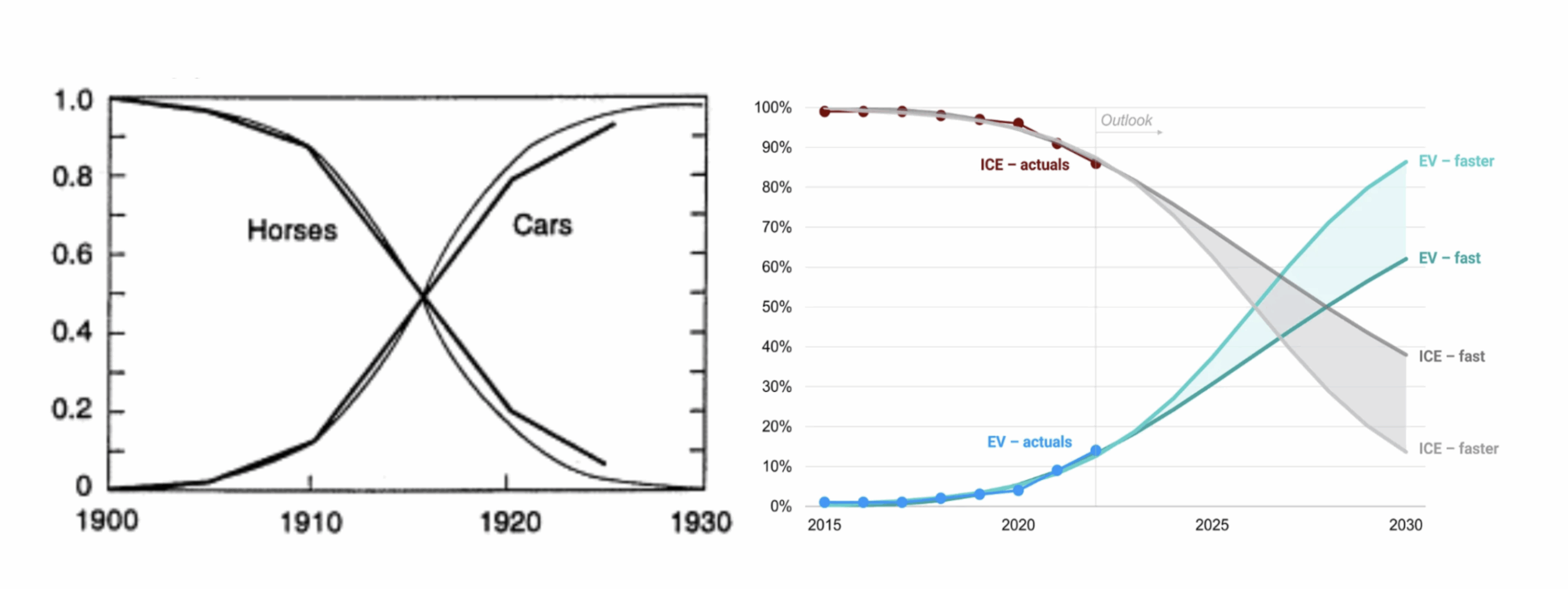
Internal combustion engine (ICE) vehicles did not prevail in becoming the dominant mode of transport through technical superiority alone. They were backed by massive public investment in roads, city planning, zoning and highway expansion funded by fuel taxes.
Meanwhile, they faced few penalties for pollution and externalities, benefitting from implicit subsidies over cleaner alternatives. Standardisation, industrial policy and wartime procurement further entrenched the ICE.
EVs are well-positioned to follow a faster trajectory, as they directly substitute ICE vehicles while being cleaner, cheaper and quieter to run.
Past transitions show that like-for-like replacements – such as black-and-white to colour TVs – tend to diffuse faster than entirely novel products.
Late adopters also benefit from cost reductions and established norms. For example, car ownership took 60 years to diffuse across the US, but just 20 years in parts of Latin America and Japan.
In today’s globalised economy, knowledge, capital and supply chains travel faster still. Our research suggests that the global EV shift could be achieved within decades, not half a century.
Yet without decisive policy, investment and coordination, feedback loops could slow, locking in fossil-fuel dependence.
Our research suggests that further supporting the widespread deployment of EVs hangs on three interlinked actions: supporting adoption; integrating with clean electricity systems; and ensuring sustainability across supply chains and new mobility systems.
Closing the cost gap
EVs have long offered lower running costs than ICE vehicles, but upfront costs – while now cost-competitive in China, parts of Europe and in growing second-hand markets – remain a major barrier to adoption in most regions.
While battery costs have fallen sharply – lithium-ion battery packs fell by 20% in 2024 alone – this has not fully translated into lower retail vehicle prices for consumers.
In China, a 30% fall in battery prices in 2024 translated into a 10% decline in electric SUV prices. However, in Germany, EV retail prices rose slightly in 2024 despite a 20% drop in battery costs.
These discrepancies reflect market structures rather than cost fundamentals. Our report suggests that a competitive EV market, supported by transparent pricing and a strong second-hand sector, can help unlock cost parity in more markets.
Beyond the sale of EVs, government policy around running costs, such as fuel duty, has the potential to disincentivse EV adoption.
For example, New Zealand’s introduction of road-pricing for EVs contributed to a collapse in registrations from nearly 19% of sales in December 2023 to around 4% in January 2024.
EV-specific fees have also been introduced in a number of US states. Last month, the UK also announced a per-mile charge for EVs – but not ICEs – from 2028.
Addressing the loss of fuel-duty revenue as EVs replace ICE vehicles is a headache for any government seeking to electrify mobility.
However, to avoid slowing diffusion, new revenues could be used to build out new charging infrastructure, just as road-building was funded as the ICE vehicle was scaling up.
While subsidies to support upfront costs can help enable EV adoption, the best approach to encouraging uptake is likely to shift once the sector moves into a phase of mass diffusion.
Targeted support, alongside innovative financing models to broaden access, from blended finance to pay-as-you-drive schemes, could play a greater role in ensuring lower-income drivers and second-hand buyers are not left behind.
Mandates as engines of scale
Zero-emission vehicle (ZEV) mandates and ICE phase-out deadlines can reduce costs more effectively than alternatives by guaranteeing market scale, our research finds, reducing uncertainty for automakers and pushing learning rates forward through faster production.
California’s ZEV mandate was one of the first in the 1990s, a policy that has since been adopted by ten other US states and the UK.
China’s NEV quota system has produced the world’s fastest-growing EV market, while, in Norway, clear targets and consistent incentives mean EVs now account for nearly all of new car sales. These “technology-forcing” policies have proved highly effective.
Analyses consistently show that the long-run societal benefits of sales mandates for EVs far outweigh their compliance costs.
For example, the UK’s ZEV mandate has an estimated social net present value of £39bn, according to the government, driven largely by emissions reductions and lower running costs for consumers.
Benefits can also extend beyond national borders. For example, California’s “advanced clean cars II” regulations – adopted by a number of US states and an influence on other countries – have been instrumental in compelling US automakers to develop and commercialise EVs, which can, in turn, trigger innovation and scale to reduce costs worldwide.
Research suggests that, where possible, combining mandates and incentives creates further synergies: mandates alleviate supply-side constraints, making subsidies more effective on the demand side.
Public charging: a critical bottleneck
Public charging is one of the most significant impediments to EV adoption today.
Whereas EVs charged at home are substantially cheaper to run than ICE vehicles, higher public charging costs can erase this benefit – in the UK, this can be up to times the home equivalent.
While most homes in the UK, for example, do have access to off-street parking, there are large swathes of low-income and urban households without access to private driveways. For these households, a lack of cheap public charging has been described as a de facto “pavement tax”, which is disincentivising EV adoption and resulting in an inequitable transition.
Our research shows that a dual-track charging strategy could help resolve the situation. Expanding access to private charging – through cross-pavement cabling, “right-to-charge” legislation for renters and planning mandates for new developments could be combined with strategic investment in public charging, to overcome the “chicken-and-egg” problem for investors uncertain about future EV demand.
Meanwhile, “smart charging” in public settings – where EV demand is matched with cheaper electricity supply – can also help close the affordability gap, by delivering cheap off-peak charging that is already available to those charging at home.
The Centre for Net Zero’s research shows that drivers respond to dynamic pricing outside of the convenience of their homes, which reduces EV running costs below those of petrol cars.
The figure below shows that, while the level of discount being offered had the strongest impact, lower-income areas showed the largest behavioural response, indicating that they may stand to gain the most from a rollout of such incentives.

Our research suggests that policymakers could encourage this type of commercial offering by creating electricity markets with strong price signals and mandating that these prices are transparent to consumers.
Integrating with clean electricity grids
Electrification is central to decarbonising the world’s economies, meaning that sufficient capacity on electricity networks is becoming a key focus.
For the rollout of EVs, pressure will be felt most on low-voltage “distribution” networks, where charging is dispersed and tends to follow existing peaks and troughs in domestic demand.
Rather than responding to this challenge by just building out the grid – with the corresponding economic and political implications – making smart charging the norm could help mitigate pressure on the network.
Evidence from the Centre for Net Zero’s trials shows that AI-managed charging can shift EV demand off-peak, reducing residential peak load by 42%, as shown in the chart below.
Additionally, the amount of time when EVs are plugged in but not moving is often substantial, giving networks hours each day in which they can shift charging, targeting periods of low demand or high renewable output.

The system value of this flexible charging is significant. In the UK, managed charging could absorb 15 terrawatt hours (TWh) of renewable electricity that would otherwise be curtailed by 2030 – equivalent to Slovenia’s entire annual consumption.
For these benefits to be realised, our research suggests that global policymakers may need to mandate interoperability across vehicles, chargers and platforms, introduce dynamic network charges that reflect local grid stress and support AI-enabled automation.
Bi-directional charging – which allows EVs to export electricity to the grid, becoming decentralised, mobile storage units – remains underexploited. This could allow EVs to contribute to the capacity of the grid, helping with frequency and providing voltage support at both local and system levels.
The nascency of such vehicle-to-grid (V2G) technology means that penetration is currently limited, but there are some markets that are further ahead.
For example, Utrecht is an early leader in real-world V2G deployment in a context of significant grid congestion, while Japan is exploring the use of V2G for system resilience, providing backup power during outages. China is also exploring V2G systems.
Our research shows that if just 25% of vehicles across six major European nations had V2G functionality, then the theoretical total capacity of the connected vehicles would exceed each of those country’s fossil-fuel power fleet.
Mandating V2G readiness at new chargepoints, aligning the value of exports with the value to the system and allowing aggregators to pool capacity from multiple EVs, could all help take V2G from theory to reality.
A sustainable EV system
It is important to note that electrification alone does not guarantee sustainability.
According to Rocky Mountain Institute (RMI) analysis, the total weight of ore needed to electrify the world’s road transport system is around 1,410mtonnes (Mt). This is 40% less than the 2,150Mt of oil extracted every year to fuel a combustion-based system. EVs concentrate resource use upfront, rather than locking in fossil-fuel extraction.
Moreover, several strategies can reduce reliance on virgin minerals, including recycling, new chemistries and improved efficiency.
Recycling, in particular, is progressing rapidly. Some 90% of lithium-ion batteries could now be recycled in some regions, according to RMI research. Under an accelerated scenario, nearly all demand could be met through recycling before 2050.
Finally, while our report focuses largely on EVs, it is important to highlight that they are not a “silver bullet” for decarbonising mobility.
Cities such as Seoul and New York have demonstrated that micromobility, public transport and street redesign can cut congestion, improve health and reduce the number of overall vehicles required.
Better system design reduces mineral demand, lowers network strain and broadens access.
The ‘decision decade’ ahead
Policy decisions made today will determine whether EVs accelerate into exponential growth or stall.
Our research suggests that governments intent on capturing the economic and environmental dividends of electrified mobility are likely to need coherent, cross-cutting policy frameworks that push the market up the steep climb of the EV S-curve.
The post Guest post: How to steer EVs towards the road of ‘mass adoption’ appeared first on Carbon Brief.
Guest post: How to steer EVs towards the road of ‘mass adoption’
-
Greenhouse Gases5 months ago
Guest post: Why China is still building new coal – and when it might stop
-
Climate Change5 months ago
Guest post: Why China is still building new coal – and when it might stop
-
Climate Change2 years ago
Spanish-language misinformation on renewable energy spreads online, report shows
-

 Greenhouse Gases2 years ago
Greenhouse Gases2 years ago嘉宾来稿:满足中国增长的用电需求 光伏加储能“比新建煤电更实惠”
-
Climate Change Videos2 years ago
The toxic gas flares fuelling Nigeria’s climate change – BBC News
-

 Climate Change2 years ago
Climate Change2 years ago嘉宾来稿:满足中国增长的用电需求 光伏加储能“比新建煤电更实惠”
-

 Carbon Footprint2 years ago
Carbon Footprint2 years agoUS SEC’s Climate Disclosure Rules Spur Renewed Interest in Carbon Credits
-
Renewable Energy6 months ago
US Grid Strain, Possible Allete Sale




